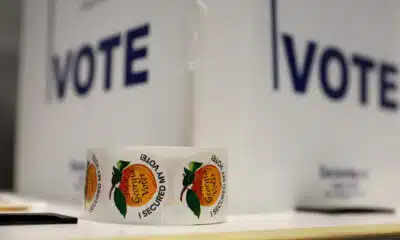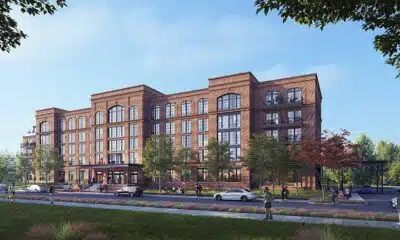News from the South - Texas News Feed
Chronic pain could qualify Texans for medical marijuana under bill
“Texas House signals expanding state’s medical marijuana program” was first published by The Texas Tribune, a nonprofit, nonpartisan media organization that informs Texans — and engages with them — about public policy, politics, government and statewide issues.
Sign up for The Brief, The Texas Tribune’s daily newsletter that keeps readers up to speed on the most essential Texas news.
The Texas House advanced a bill Monday that would expand the conditions eligible for the state’s medical marijuana program, including chronic pain and Crohn’s disease, and allow for prescribed smokable products to be sold by prescription.
House Bill 46 by Rep. Ken King, R-Canadian, would allow patients in the state’s medical marijuana program to use products like cannabis patches, lotions, and prescribed inhalers and vaping devices. The House preliminarily approved the bill 118 to 16 on Monday and will need a final round of approval before it heads to the Senate.
If it becomes law, the list of qualifying conditions would also expand to include chronic pain, traumatic brain injury, Crohn’s disease, and degenerative disc disease. The bill would also let licensed dispensers open more satellite locations, which supporters say is necessary to prevent the industry from crumbling.
“There are too many Texans who are still struggling to get access to the medicine they legally have a right to receive,” King said, pointing out his bill would allow for additional dispensing locations outside of Central Texas, where all dispensaries are currently concentrated.
Rep. Penny Morales Shaw, D-Houston, said rural Texans would have more access.
“Too many of our fellow Texans are forced to either suffer or self medicate because they don’t have sufficient access, and this is an amazing alternative to addictive, harmful opioids, which we know is a huge problem,” she said.
In Texas, licensed medical cannabis providers must house all operations, including cannabis cultivation, processing, extracting, manufacturing, testing, and dispensing, under one roof.
State regulations also prohibit inventory storage of medical cannabis products in multiple locations, so products must be distributed from the central dispensary. Any prescriptions scheduled for pickup outside the central dispensary must be driven daily to and from the pickup location—sometimes thousands of miles round-trip.
“This method puts wear and tear on our vehicles. Limits the amount of time we can spend with patients and can compromise product integrity,” said Terrence Baugh, marketing manager for goodblend, Austin-based medical marijuana producer. “We might drive 200 miles, and the person we are delivering to might not even be there at the moment.”
This has made their products more expensive and limited where the medical marijuana program can reach, hampering the small medical cannabis market in Texas.
“We also don’t have enough doctors in the program, and not enough people prescribing for it, and most patients find us through a doctor. We are dealing with several different challenges, but we are hopeful these bills might help,” said Baugh.
House Bill 46 is meant to correct some of this problem by allowing medical marijuana distributors to store their products in various satellite locations instead of having to drive across the state to return the product every day.
However, the most significant potential change would be allowing smokable marijuana products, such as vapes, to be introduced into the program, helping to match the popularity of products found in the hemp industry. The Texas medical program can currently only sell gummies, lozenges, topicals, beverages, and tinctures, as smoking or vaping products have not been approved.
Many hemp products, which are unregulated and sold more freely in smoke shops, also give the same high as medical marijuana, but are cheaper for consumers, and don’t require a visit to a medical professional for pre-approval to purchase. This ease of access has pretty much made the medical marijuana program irrelevant, according to the medical marijuana industry.
Dillan Dabelsutt, senior manager of cultivation at goodblend, said the only difference between hemp and medical marijuana is that hemp is harvested earlier.
“Hemp is just a little more flexible while marijuana is produced for high THC alone,” he said.
By allowing smokeables and expanding the conditions, the medical marijuana producers are hoping this will open the market up to more patients and increase the demand for products.
Texas lawmakers are also determining the future of hemp this session, as a House panel approved last month a bill, also authored by King, to tighten regulations on Texas’ consumable hemp industry, setting up a potential clash with Lt. Gov. Dan Patrick and the Senate, who are pursuing a total ban on THC products.
“I think we can co-exist with hemp. We just want an even playing field,” said Baugh. “I believe additional regulations are needed on hemp, and we need to loosen some on medical marijuana.”
King noted on Monday that HB 46 would have no effect on hemp and that the future of that industry will be decided another day.
“The other bill will be coming to a House floor near you,” he told lawmakers.
Texans seeking help for substance use can call the Substance Abuse and Mental Health Services Administration’s free help line at 800-662-4357. They can also access services in their region through the Texas Health and Human Services website.
First round of TribFest speakers announced! Pulitzer Prize-winning columnist Maureen Dowd; U.S. Rep. Tony Gonzales, R-San Antonio; Fort Worth Mayor Mattie Parker; U.S. Sen. Adam Schiff, D-California; and U.S. Rep. Jasmine Crockett, D-Dallas are taking the stage Nov. 13–15 in Austin. Get your tickets today!
This article originally appeared in The Texas Tribune at https://www.texastribune.org/2025/05/12/texas-marijunia-medical-chronic-pain-crohns-cancer-glaucoma-ptsd/.
The Texas Tribune is a member-supported, nonpartisan newsroom informing and engaging Texans on state politics and policy. Learn more at texastribune.org.
The post Chronic pain could qualify Texans for medical marijuana under bill appeared first on feeds.texastribune.org
Note: The following A.I. based commentary is not part of the original article, reproduced above, but is offered in the hopes that it will promote greater media literacy and critical thinking, by making any potential bias more visible to the reader –Staff Editor.
Political Bias Rating: Centrist
The article appears to focus on reporting the progress of House Bill 46 in Texas, which aims to expand the state’s medical marijuana program. It provides factual details on the bill, its intended effects, and reactions from various stakeholders, including lawmakers from different political backgrounds. The tone remains largely neutral, presenting the views of both proponents, such as Rep. Ken King, and supporters from the medical marijuana industry, while also briefly touching on opposing perspectives without strong ideological persuasion. This suggests the content leans toward a centrist stance, focusing on policy discussion without promoting a specific political viewpoint.
News from the South - Texas News Feed
It's a love story: Taylor Swift, Travis Kelce announce engagement
SUMMARY: Taylor Swift and Kansas City Chiefs tight end Travis Kelce are engaged, announcing it on Instagram with a photo of Kelce proposing in a garden and showcasing Swift’s dazzling “Old Mine brilliant cut” ring. The couple, both 35, began dating in 2023 after Kelce attended Swift’s Eras Tour. Despite early challenges, including Kelce’s unsuccessful attempt to give Swift a friendship bracelet with his number, their relationship blossomed. Swift has supported Kelce at numerous games, including two Super Bowls, while Kelce frequently attends her concerts. Their relationship has garnered massive media attention and was featured in ESPN’s documentary “The Kingdom.” Kelce’s parents praise their bond as genuine and deserving.
The post It's a love story: Taylor Swift, Travis Kelce announce engagement appeared first on www.kxan.com
News from the South - Texas News Feed
We're excited for National Dog Day!
SUMMARY: To celebrate National Dog Day, the studio welcomed three dogs: Mac, Sandy, and Leo. Sandy sports a playful lipstick kiss from Kim Castro, while lively one-year-old Leo kept everyone entertained. The dogs’ owners, also producers, shared that it’s usually breakfast, walk, or nap time for them. The studio enjoyed the furry therapy vibe and encouraged viewers to treat their dogs with special offers from PetSmart (buy one, get one 25% off on treats), Lazy Dog Restaurant and Bar (coupon with dog bowl and entree), and free Puppuccinos from Starbucks. Viewer-submitted dog photos added to the joyful celebration of our furry friends.
We had in-studio guests to help us celebrate.
News from the South - Texas News Feed
Racism Wrapped in Rural Warmth
Rural Texas wears a friendly facade. You know everyone, and everyone treats each other so kindly, but, if you’re Black, you just ignore the stares when you walk into the local steakhouse for fish fry night.
I was 7 or 8 when I realized I would always be treated differently than my white friends. It was picture day and I was waiting in line near our classroom and watching as my teacher fixed every girl’s hair. I eagerly waited for her to fix mine, but she never did. I assumed it was because my hair was already twisted into three cute ponytails, a classic hairstyle for little Black girls.
But when I got home and asked my mom, she told me my teacher didn’t know what to do since my hair had a different texture than my friends’.
When I was in the seventh grade, I was called the n-word. I didn’t need to ask my mom what the word meant; I already knew. You’re taught at a young age if you’re Black. You’re taught never to say that word. It’s a slur. It’s a dirty word. The kid who called me that slur was a bully and I was a straight-A/B student. I never did anything wrong. (I can’t even tell you what detention was like!) My mom expected the best, so I became the best I could be. I remember telling her and crying. I was hurt.
A day later, he apologized after my mom told the school. I was surprised the school took action even in the early 2000s. I don’t recall being called that slur again. This was part of the good side of growing up in a place I’ll call “Smallstown” (since I still live here), a southeast Texas town where about one in five residents is Black. Many people try to do the right thing.
But throughout my academic and personal life, I experienced subtler forms of small-town racism—warm and welcoming with flashes of ugliness.
In 2005, my brother, mom, and I went to a local clothing store to buy a suit for his high school prom. As soon as we opened the door, we were immediately greeted. You would think that would be amazing customer service, but it wasn’t friendly. Family friends, who are also Black, told us they’d gotten the same greeting—it was pure racism.
Being stopped at the door was embarrassing. My family doesn’t steal. If I can’t afford it then I don’t need it. No one in my family has shopped there since. But to this day, I still get followed at a local big box store, especially when I’m eyeing the latest gaming systems.
My mom raised me to be intelligent and to think creatively. I grew up around books and learned about the world around me. I was raised on academics and hoped my smarts and studies would take me far.
Sometimes I was made fun of for talking “white.” (To this day, I have no idea what that meant.) I didn’t speak like the other Black kids did so I suppose that gave others something to laugh about—a kind of reverse racism.
In high school, I discovered a love for rock music. I was the only Black girl at Smallstown High who listened to rock. I loved Slipknot and other popular bands. I still do. I remember a particularly odd moment in history class my senior year. Our teacher was a coach and, for him, the stereotype was true: Coaches that teach often don’t care about the subject. One day my musical preferences came up in class and the teacher said, “You’re a Black girl who likes rock music? I would have dated you in high school.” Everyone thought that was weird.
In 2007, I escaped Smallstown to attend Sam Houston State University (SHSU) in Huntsville, where fortunately, I had fewer experiences with racism. But I recall that when Barack Obama was reelected I and other Black students got a text warning us to stay indoors. Otherwise, nothing stood out. I felt my race didn’t matter in Huntsville. The “townies” (we loved calling Huntsville people that as if they were the visitors and we weren’t) treated me differently only because I was a college student—a younger, less-rooted resident. On campus, we treated each other like longtime friends. I joined the Black Student Alliance, the NAACP, and the Program Council. I befriended many people who didn’t treat me differently because of my race.
For years, I wondered why, and I think it’s because so many SHSU students grew up in bigger cities. When I mentioned how insular Smallstown was, they seemed confused. By the time I graduated, I had learned a lot about myself. The lessons I learned and the people I met stay with me.
But then I moved back to Smallstown. Some strangers stopped me to ask if I was aware of what shirt I was wearing. (Yes, it featured my favorite heavy metal band.) And others still spoke to me as if I were a child. I was shocked to realize that my experiences as a Black woman in rural Texas wouldn’t change just because I had gained a bachelor’s degree.
I started working at a grocery store after college. The managers there never treated me differently due to my race—they treated me well because I was a hard worker. But some customers dealt with me differently because I was Black. The store had a small gas station, and I worked inside a little kiosk surrounded by fuel pumps. Every now and then, some white customers treated me as if I knew much less than the white co-workers I’d trained.
Compared to Huntsville, Smallstown has a big socioeconomic divide. Generations of white families in our town were able to buy homes and grow businesses while Black families were redlined and segregated and forced to attempt to break generational curses. But rich White people generally were less racist while poorer ones tended to belittle Black people. I found the nicest visitors to the grocery store were often ranchers and farmhands who drove in from the country.
I often wonder what would spark a change in the attitudes people have about Black people in small-town Texas. I hope that people like me, and the younger generations, will be able to inspire a much-needed change. Change comes from within and through open discussions. Frankly, I would have expected that racism would have faded already by 2025, but it hasn’t. People seem stuck in denial and defense mode whenever a Black person speaks about racism. You hear: “Oh, I can’t be racist because I have a Black friend,” or, my personal favorite, “There’s not a racist bone in my body.”
For real change to happen, people need to be ready to recognize things within themselves. I am hoping to open some eyes by sharing some of my experiences about being a Black woman in rural Texas.
The post Racism Wrapped in Rural Warmth appeared first on www.texasobserver.org
Note: The following A.I. based commentary is not part of the original article, reproduced above, but is offered in the hopes that it will promote greater media literacy and critical thinking, by making any potential bias more visible to the reader –Staff Editor.
Political Bias Rating: Center-Left
This content focuses on the personal experience of a Black woman facing racial discrimination in rural Texas, highlighting systemic and interpersonal racism. The narrative advocates for recognition of racial issues and social change, which aligns with values typically associated with center-left perspectives emphasizing social justice and equity. While it critiques aspects of society and calls for progress, it does so through personal storytelling rather than overt political rhetoric, avoiding extreme or highly partisan language.
-
Our Mississippi Home7 days ago
MSU Unveils Mixed-Use Development Featuring Boutique Hotel, Cultural Landmark
-
News from the South - Alabama News Feed7 days ago
Grants to boost local emergency alert systems in question as public media agency closes
-
News from the South - Arkansas News Feed6 days ago
New I-55 bridge between Arkansas, Tennessee named after region’s three ‘Kings’
-
News from the South - Arkansas News Feed7 days ago
‘Alligator Alcatraz’ probed by Dems as ICE detention centers multiply in states
-
News from the South - Texas News Feed3 days ago
DEA agents uncover 'torture chamber,' buried drugs and bones at Kentucky home
-
Local News7 days ago
Winged ferry that glides like a pelican tested for coastal transportation
-
News from the South - North Carolina News Feed7 days ago
How civics class could stage a comeback in NC schools
-
News from the South - Louisiana News Feed6 days ago
Families with citizen children deported by ICE sue Trump administration











































